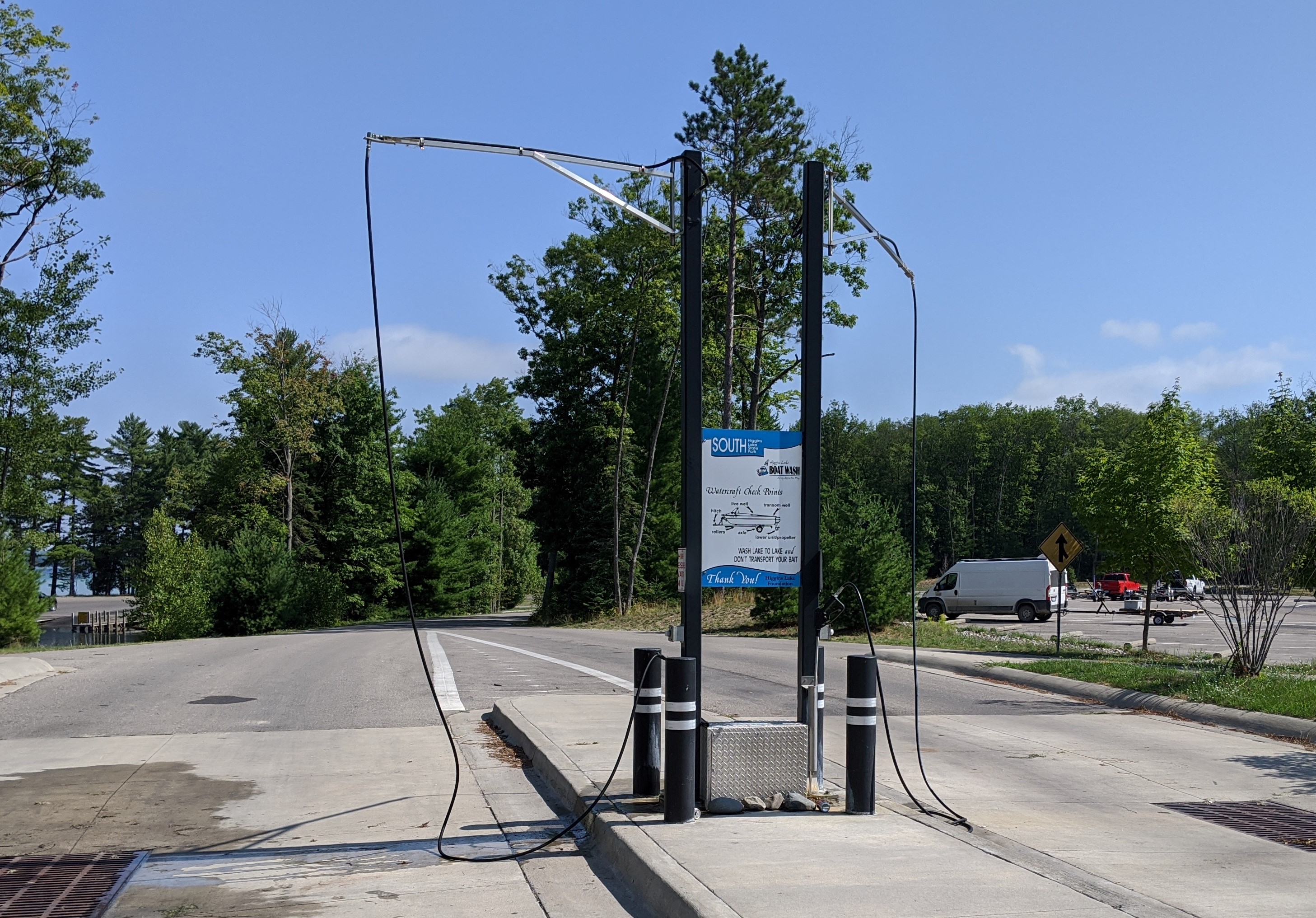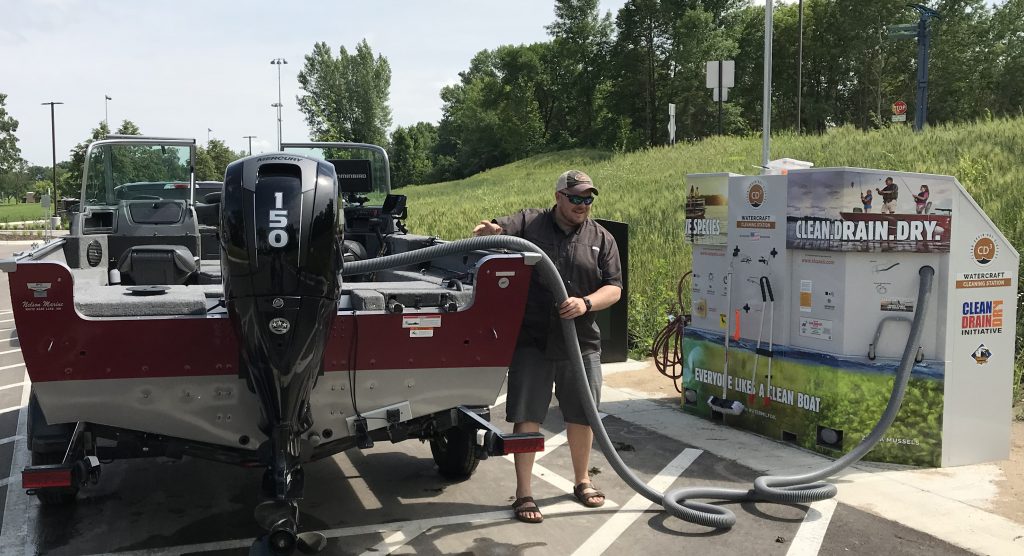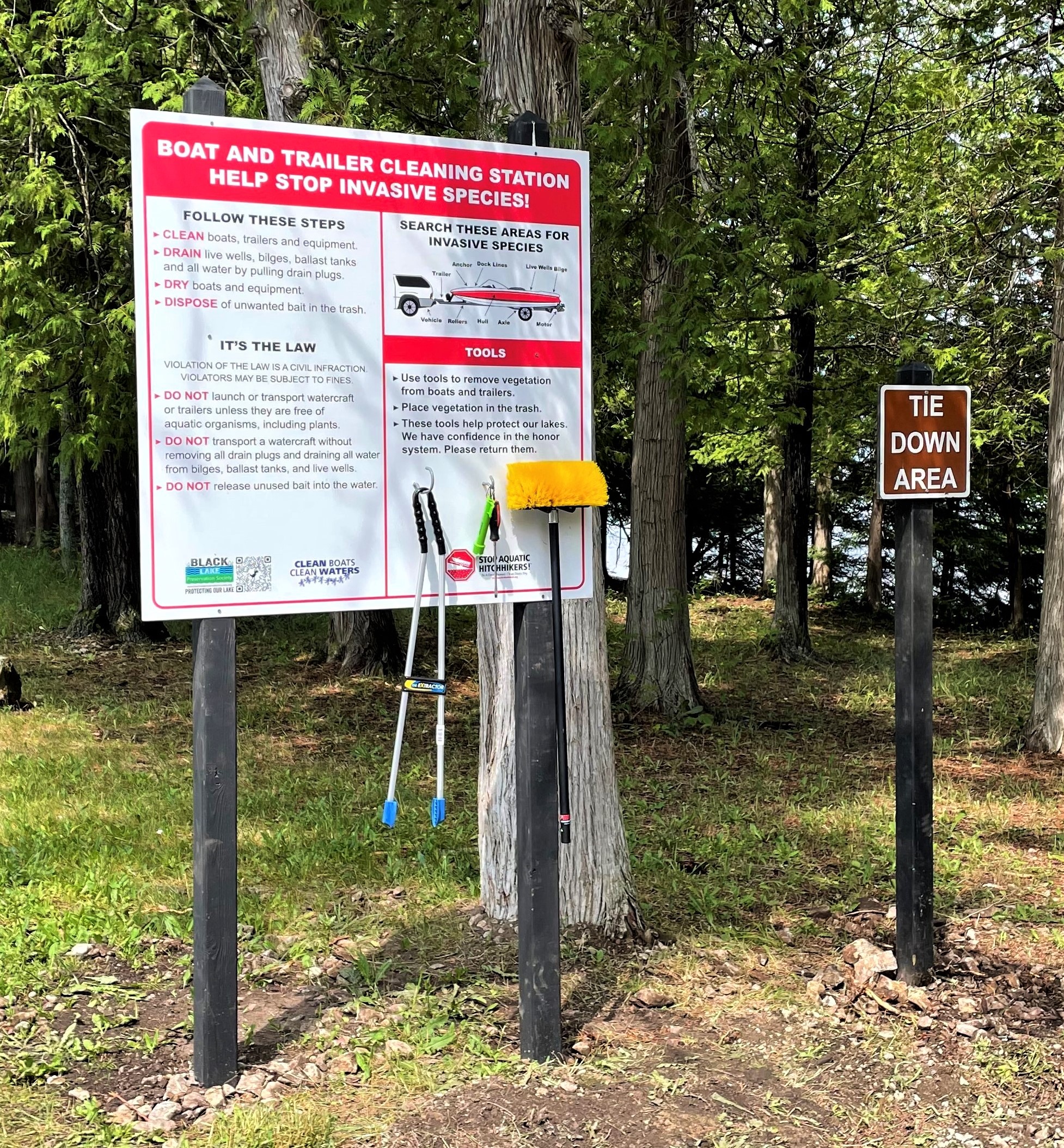Boat cleaning equipment at launch sites can stop the spread of aquatic invasive species
Available systems vary in approach, effectiveness, and cost.

Aquatic invasive species (AIS) can invade new waterways when they are carried in the bilge water of boats, tangled on watercraft propellers or trailers, or when they are attached to equipment like fishing lines. According to the Michigan Invasive Species Program, European frog-bit and starry stonewort are two examples of AIS that pose a serious threat to Michigan waterbodies. They form dense mats of vegetation that block sunlight, outcompete native plants, and interfere with our ability to enjoy lakes and rivers.
Once introduced, invasive species are very difficult and expensive to remove, and often treatments must be repeated. Therefore, AIS experts are encouraging communities to focus on prevention strategies, such as installing boat cleaning systems, to make it easy for boaters to remove AIS when they are entering or leaving a waterbody. A boat cleaning system is any equipment (e.g., grabber tools, brushes, power washers) provided at a boat launch that helps remove or kill AIS on a watercraft. Available systems are diverse in size, cost, and cleaning method. Some systems are permanently installed in one location, while others are trailer mounted and easily transported.
Communities with boat launches, like decontamination equipment, are diverse and one system does not fit all scenarios. Several factors should be considered when selecting a boat cleaning system to control AIS at boat launches. The first is the short and long-term cost of the equipment. Organizations should select a system supported by the financial resources available, considering operation, maintenance, transportation and staffing costs. Second, each cleaning system has advantages and disadvantages related to its usage and decontamination effectiveness. The most effective boat cleaning system is one that is frequently used, even if its decontamination effectiveness is lower than other options. For example, hot water cleaning systems are typically the most effective at killing and removing AIS from watercraft; however, heated water requires trained operators and permanent stations are not feasible at all boat launches. Unheated, high pressure water or waterless cleaning stations can be safely operated by first-time users, may be more practical at some boat launches due to size and cost, and still decrease the risk of AIS spread.
Boat Washing Equipment
High Pressure, Hot Water Cleaning System

Hot water decontamination equipment includes a boiler tank and hose or spray gun that rinses the exterior and interior of the boat with very hot water, removing attached AIS and killing any that remain. Hot water is an environmentally benign method that effectively kills most AIS and is recommended by several government agencies in western states. In order to compensate for the cooling of the water between the spray hose and contact with AIS, water is heated to 60 degrees Celsius (140 degrees Fahrenheit), although due to the risk of damaging the boat, interior compartments require lower temperatures when sprayed for long durations. Organizations with these systems typically hire and train staff to protect themselves from liability claims. Hot water systems can be permanently installed or attached to a trailer and moved to various locations. Hot water systems may also offer a heat free high-pressure spray setting.
Cost: $$$. This is the most expensive boat cleaning system available when it is permanently installed at a boat launch. The high price is due to the cost of the equipment, operation, maintenance, installation (engineering, construction, power and water sources, wastewater disposal, and associated permits) and the need for trained staff to operate the boat wash. A mobile unit is less expensive; however, added costs include a tow vehicle, fuel, staffing and maintenance.
High Pressure Cleaning System

Unheated, high-pressure water decontamination equipment includes a spray gun that rinses the exterior of the boat. These systems can effectively remove aquatic plant fragments and small seeds, but do not kill AIS on contact. Unlike hot water cleaning, high-pressure water spray is not often used to flush out the interior compartments of a boat (bilge, live well, engine, ballast tanks) due to the risk of damage. This could be an obstacle to decontamination because AIS in interior compartments could survive a multi-day journey to a new waterbody. High pressure decontamination systems exist as trailer mounted units or can be permanently installed.
Cost: $$. This is a less expensive option, although a permanent station will have many of the same installation costs as a hot water system including equipment, operation, maintenance and installation (engineering, construction, power and water sources, wastewater disposal, and associated permits). While trailer mounted units are less expensive, they still require a tow vehicle, fuel, staffing and maintenance.
Waterless Cleaning System

Waterless cleaning systems can be set up with a variety of tools, including a grabber tool for removing aquatic plants from hard-to-reach places, a plug wrench to extract the drain plug and drain the bilge, a vacuum to remove residual water, a brush to remove mud and compressed air to dry the watercraft. Waterless systems can also be as simple as an aluminum sign with AIS removal tools and instructions. When dry, hitchhiking AIS do not survive. Five days of drying time are typically recommended before a watercraft is safe to launch in another waterbody, although using a waterless cleaning system to remove residual water may result in the boat becoming completely dry in less time.
Cost: $. This is the least expensive option and does not require advanced construction. However, there are reoccurring maintenance costs, such as tool replacement.
Educational signage and events are valuable for boaters

No matter the type of boat wash, signage should be placed at the cleaning station with clear and concise instructions. Research shows that word choice and tone of outreach materials may affect a boater’s willingness to use boat washing equipment. Educational signage should be large, use imagery and be placed where it will not be obscured by vegetation.
During educational events, staff or volunteers should be mindful of their tone, appearance and timing when approaching boaters. Staff who connect with boaters and treat them as guests will be more successful in engaging those boaters in conversation than staff who approach with a serious expression and clipboard in hand. Boaters may also be reluctant to engage when they are busy trying to back up their trailer or attend to young family members. An example of a successful AIS boater education program is the Michigan State University Mobile Boat Wash. Staff of that program have incorporated these lessons into their boat washing events and emphasize their university affiliation by wearing university colors and displaying the MSU logo. University-related topics turn out to be good conversation starters.
Also, any education that makes it clear that boaters are socially expected to clean their boats will be successful at yielding boat-cleaning behavior. The belief that other boaters are judging one when ignoring an AIS cleaning station is a strong incentive to participate in cleaning actions. Michigan State University Mobile Boat Wash staff have frequently observed boaters lining up to have their boats washed after they have witnessed someone else participating.
For More Information
To learn more about boating and aquatic invasive species visit the Michigan Clean Boats, Clean Waters website. Since 2006, Clean Boats, Clean Waters has been engaging communities in the prevention of AIS through boater education. The program is a joint effort between Michigan State University Extension and the Michigan Department of Environment, Great Lakes and Energy.
A version of this article originally appeared in the Summer 2021 issue of The Michigan Riparian magazine.



 Print
Print Email
Email




